Partially rewritten in 2022 with clearer guidance on subfloor considerations.
The two good options for protecting your gym floor are an array of rubber mats or larger rolls of rubber flooring. Let’s look at how to choose your flooring and what else you might need.
Table of Contents
Dealing With Your Subfloor Type
Depending on what you have underneath, you might need additional materials besides just the rubber flooring.
For all suggestions below with plywood, get high quality plywood sheets you have sighted as flat, not curled at all.
Concrete Floor
A bare concrete floor is an ideal starting point. With a layer of rubber it can take a beating, has no give, and should be pretty flat. You can lay rubber directly on the concrete, no fuss, easy peasy.
In a garage you may also want to take some steps to deal with the sloped garage floor.
Hardwood Floor
Hardwood, which is almost always laid over a plywood or OSB subfloor, can take some force from weights set down hard and reasonably controlled.
Put a plastic dropcloth over the hardwood before laying down the rubber, to stop the rubber from making black marks on the hardwood.
People often ask about foam underlayment. Avoid foam. It adds cushion that you don’t want.
If you want extra protection, after the dropcloth put down a layer of 3/4″ plywood, then rubber.
Tile Floor
A tile floor is in danger of cracking from your weights if you don’t use the right materials to protect it.
A cork underlayment to protect the tile is a good idea. Then a layer of 3/4″ plywood to spread out the load and provide stability. Then rubber on top.
Carpeted Floor
If it’s a really thick, luxurious carpet, that’s not going to work to build a gym on. Either the carpet goes or your gym does.
An average thickness carpet still has too much cushion, but you can deal with it if you don’t want to rip it out. Lay down a layer of 3/4″ plywood. You’ll need to connect the plywood sheets together to make them a stable solid layer to prevent the edges from moving up and down. A few connected plywood sheets can feel surprisingly solid over carpet.
Screw in mending plates to connect them. The issue there is you need to recess the mending plates into the plywood so your rubber has a flat surface to lay on.
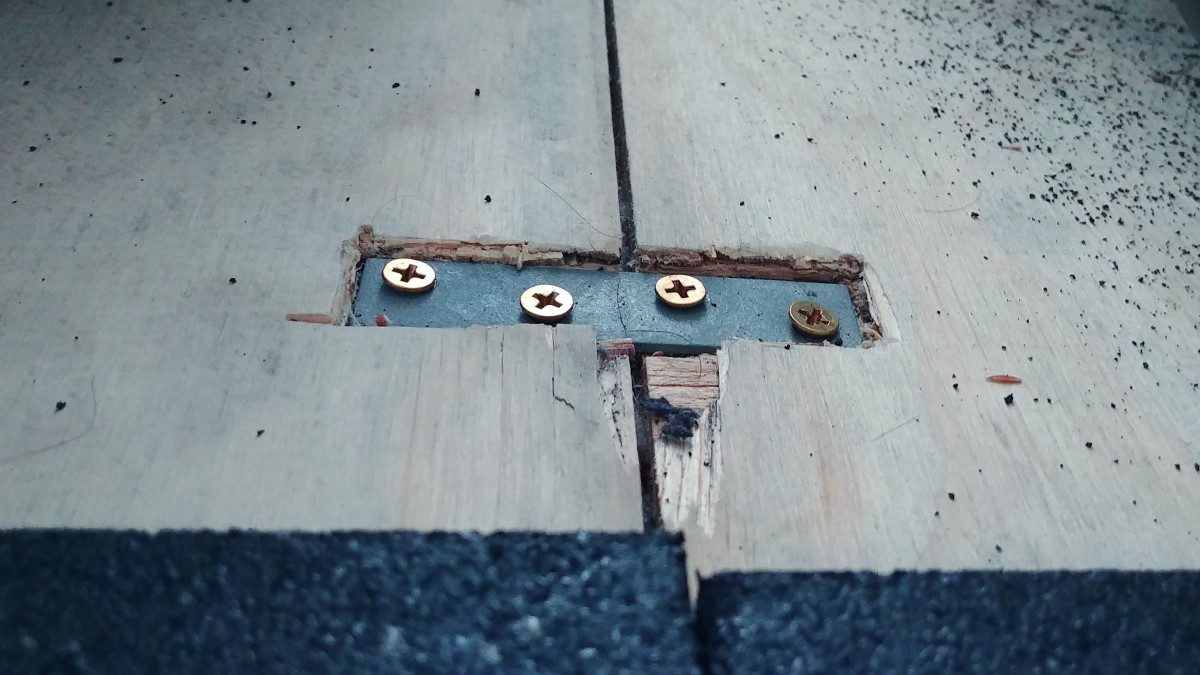
What I did was cut out slots a few layers deep into the plywood with a hammer and chisel that I could lay the mending plates in. It was a messy hack job but worked.
Thin carpet – the type used in commercial offices – you can lay mats directly on and you’ll be fine. You can lay down plastic drop cloths first if you want to keep the carpet in good shape.
4ft x 6ft Rubber Mats / Horse Stall Mats
4′ x 6′ happens to be a common size that these “horse stall mats” come in. There are larger and smaller ones. Larger than 4′ x 6′ are almost impossible for one person to handle (this size is already ~96 lbs and awkward to handle).
Basic rubber mats like this are all slip resistant, water resistant, and absorb impact.
These mats can work in a 3/8″, 1/2″, or 3/4″ thickness. Get the 3/4″ if you can. That’s the standard stall mat thickness. It protects your floor underneath the best against dropped weights. Anything thinner than 3/8″ is more like a cardio equipment mat that’s just meant to protect the floor against a treadmill or bike sitting on it and not much else.
“Stall mats”, or any mats made with recycled rubber, will stink for a time. Their odors were kept in while stacked up at the store. If you have time, and you’re just installing a few, drape each one on something outside to air them out for a while. Possibly up to a month. Otherwise just keep the room ventilated and they’ll eventually stop off-gassing.
These rubber mats can be cut to size with a few passes of a utility knife or good serrated knife. I’ve cut 3/4″ stall mats fine with a utility knife and straight edge. When possible, cut the edge that will go against the wall so that the sides against other mats are factory straight.
Drill some wood screws through the rubber and plywood to keep everything nicely in place. You will be drilling the screw head down into the rubber a bit so you don’t trip on the screw head or break it with dropped weights. For 3/4″ rubber and 3/4″ plywood, a screw length of 3/4″ works good.
For a power rack setup, 2 mats will nicely cover the floor under your rack and enough in front for your bench, a 6′ x 8′ area. Most people end up eventually buying enough mats to cover the entire room.
If you’re laying mats directly on concrete, Alan Thrall shared an idea in his “Garage Gym Flooring Hack” video to keep your mats from drifting apart:
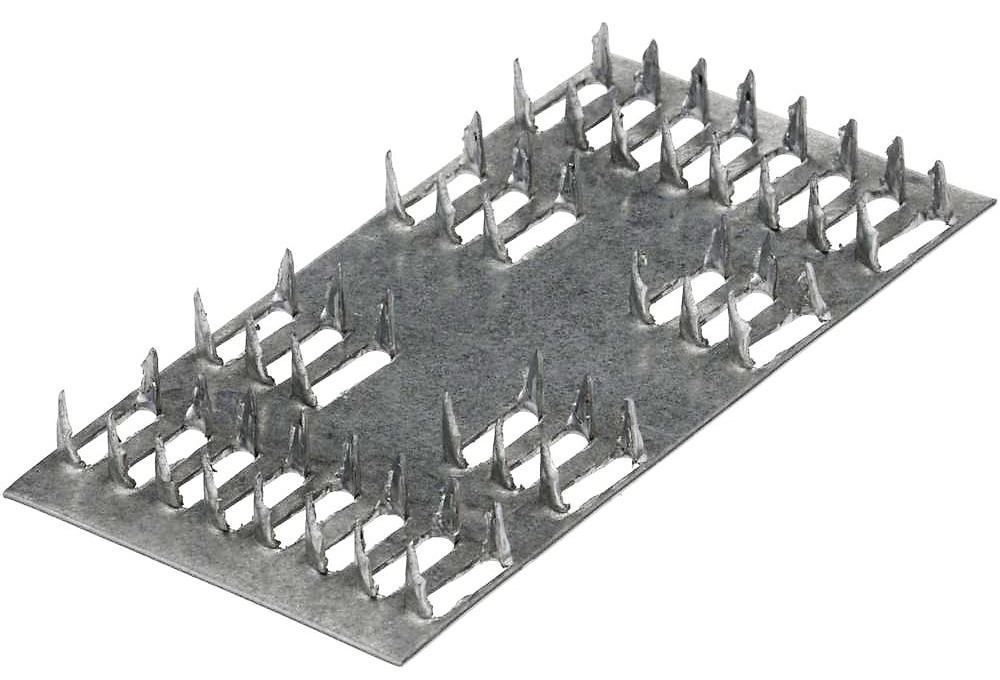
These mending plates as discussed in the video are only like a buck a piece at Home Depot.
My only objection is those teeth stab up around 3/8″ into the rubber. I wonder how much the rubber compresses when you drop a weight on it? 1/4″ teeth would be ideal for this purpose, but I have not found one that size after looking around.
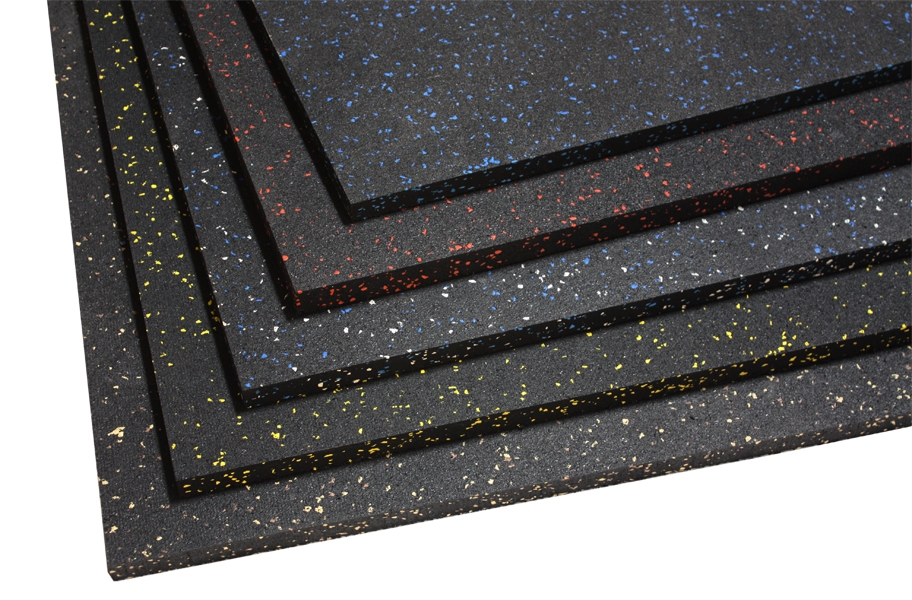
For small quantities, Rubber Flooring Inc’s Extreme Mats have been the best deal online for years running, with reasonable shipping. I ordered one mat from them to expand my area. It’s a good flat texture on top, and a rough bottom, which I think is done to help with air cushioning or to help give moisture a way to escape. All around excellent quality.
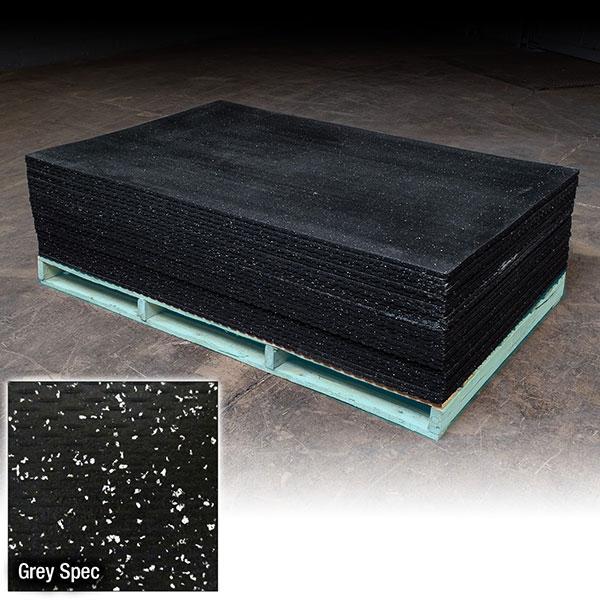
If you are filling a big area, the 25-piece skid from Rogue is one of the best deals at the moment and is cheaper than Rubber Flooring Inc per piece. If you don’t need all 25, list your extras on OfferUp or Craigslist for $60 a pop, and you’ll be rid of them in one day and make a friend.
In person, you could go to a Tractor Supply store if you have one close to you. They will have them for cheaper than you can buy in small quantities online. Shipping on 100lb mats is expensive. The problem with Tractor Supply is I have heard stories that they will source any stall mats they can get, with no regard to matching surface texture. Who knows what you’ll find, and good luck if you have to return later to try to get more for a matching set. They originally meant them for animal stalls only, and animals don’t give a rat’s ass about matching decor.
The closest Tractor Supply was 45 minutes away when I needed another mat, and the gas + travel time wasn’t worth the savings to me, leading me to just order the mat online from Rubber Flooring Inc. It arrived safely by Fedex Ground, rolled up pretty tightly (I don’t know how they managed that – these things are thick, and a normal human can’t roll it up), wrapped in plastic pallet wrap.
Rubber Rolls
For any needs larger than around 6 mats, and if you won’t be dropping weights to the point where you need 3/4″ mats, think about the nicer rolled rubber flooring that comes in 3/8″ thick.
Stall mats have some disadvantages:
- They can stink for a month or so. Stacked up on a pallet of 25 stall mats at the store doesn’t allow them to off-gas.
- The thickness of some brands can vary slightly, even from one edge of the mat to another.
- The surface texture can vary from season to season. Stores treat these like a commodity and don’t care about consistent looking texture. These were made for horses, hence the term horse stall mats.
- They can shift around over time, creating gaps.
- Sweat or spilled liquids can get into the cracks between mats
Good rubber rolls don’t have those issues.
It used to be that you had to buy entire 25ft rolls that weigh hundreds of pounds and have a professional install them. If you think a 100lb floppy stall mat is hard to move, think about what a massive roll is like.
Today everybody gets Regupol rolls custom cut to their specs. You have to fill out a form online to get a quote for your size room. One person said his price with shipping worked out to $2.36/sqft, which is in the ballpark of the price for 4’x6′ mats and of better quality.
They’ll custom cut the Regupol rolls for your area. It’s feasible to cut 3/8″ rubber yourself in a single pass with a utility knife and straight edge. I’ve done that with 3/4″ stall mats in 2 passes. But getting a partial roll (the roll sizes are 50′ long uncut) ought to save both money and time.
These rolls are only 3/8″ thick. That’s about the max thickness you’ll see in rolls from any brand.
3/8″ thick can be fine for most of your gym area or for general exercise room flooring. It will protect a concrete floor and give good footing.
For Crossfit / olympic lifting you would best double-up the rubber to absorb dropped barbells. Or add a layer of 3/4″ plywood as the bottom layer, which will be cheaper than doubling up the rubber.
Interlocking Rubber Tiles
These used to be more popular. They’re still around. I think there are so many of the cheapo EVA tiles (see the section below) that got mixed up with these real rubber tiles that they’ve undeservedly developed a bad name. There’s nothing wrong with them.
The advantage of interlocking tiles is they won’t shift around. Stall mats are known to slide around over time unless you screw them down or enclose the area with something tightly.
The disadvantage is you’ve got more seams so more possibilities for edges to stick up. That being said, well-made tiles should have uniform thickness and not stick up at any point.
I advise you to get 3/8″ (or 10mm) thick tiles. That’s about the thickest you’ll find. Double them up if you have to, as discussed in the final section of this guide.
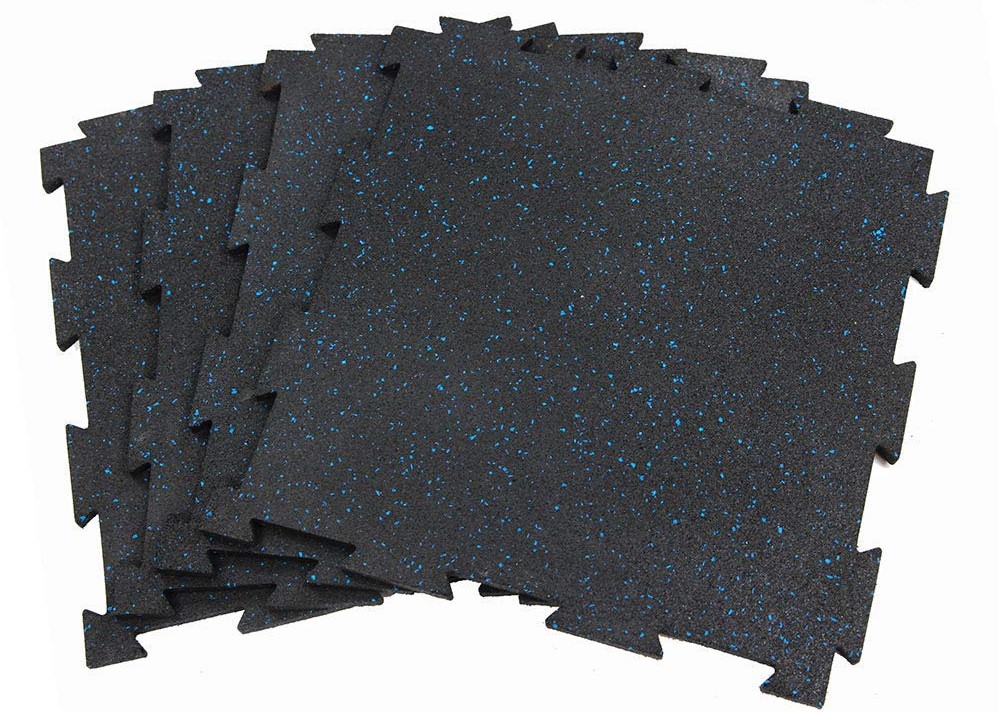
They are a little tough to find now. These tiles on Amazon look pretty good for the price.
Warning: EVA Interlocking Foam Tiles
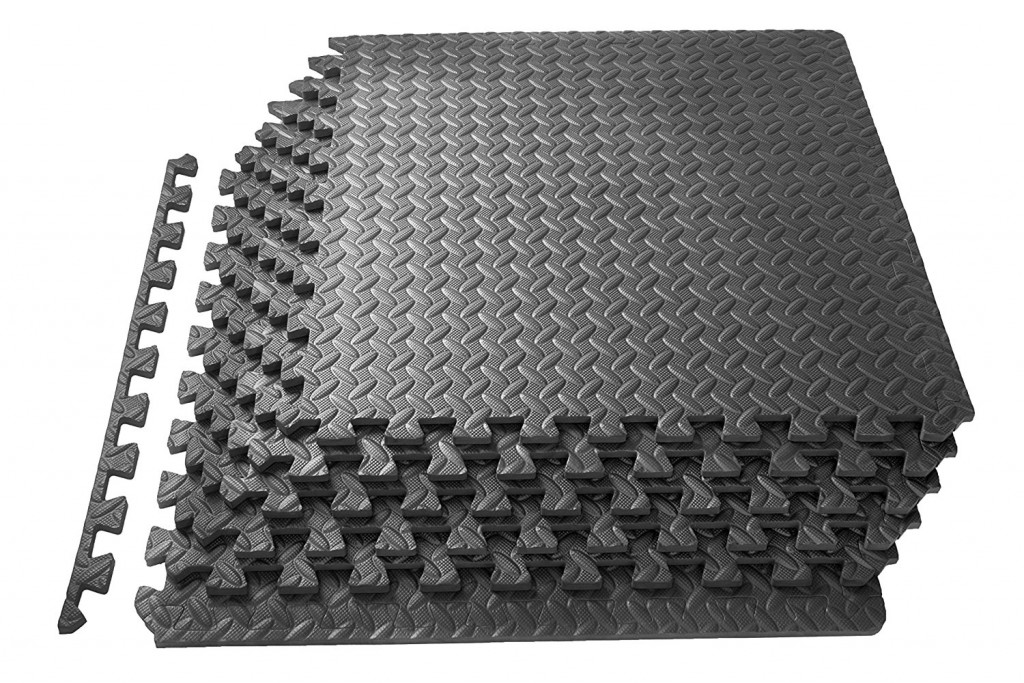
I have to mention these because they’re all over Amazon. Dozens of them fill the top search results for rubber mats or rubber flooring. They call them “foam rubber” or “soft rubber” tiles. Don’t be fooled. They aren’t rubber. They’re high density foam mats, meaning they are not insanely squishy but are still an open-cell type of foam that are significantly more squishy than rubber. You won’t be happy.
They are actually EVA mats. EVA is ethylene vinyl acetate, a material that’s excellent when used in various types of sports padding like boxing gloves, hockey pads, padded shorts, lots of stuff.
They’re extremely lightweight and easy to install. Each tile weighs mere ounces. Dirt cheap too. That’s the appeal.
They have several major issues:
- Your footing won’t be firm for any standing heavy lifts.
- The floor protection isn’t that great if you drop weights, because it’s too soft to disperse the load like rubber does
- Pieces can stretch from a little lateral force and move permanently out of alignment
- Edges can stick up for no reason at all
- If you don’t make an effort to bend each one flat before installing, they can be bowed up a little and make slapping noises against the subfloor as you step on them.
- The surface texture wears away quickly
- Equipment like a rack or weights will leave permanent indentations after a while
Lifting Platforms
For ultimate protection in dropping barbells when doing the olympic lifts, you can use a platform. You still need to use bumper plates for significant drops, but if you’re careful and not lifting a ton of weight you can do deadlifts with iron plates on a platform.
It’s two layers of plywood underneath, and on top is a another layer of hardwood in the center strip, and a layer of thick rubber on the sides. The whole thing is enclosed by a steel frame to keep it together. It’s awesome.
The width is always 8ft, to accommodate a fully-loaded 7ft barbell with room for slop. As far as the length front to back, get 8ft if you’re going to be doing olympic lifts. That will give you room to drop the barbell in front of or behind you. 6ft depth can work. For deadlifts you only need 4ft.
Putting it directly on a concrete subfloor is fine. Most commonly a lifting platform is on top of the rubber flooring that’s everywhere else in the gym.
The hardwood has just the right amount of traction if you’re using olympic lifting shoes.
If you have anything but a concrete subfloor, don’t try a platform. This won’t go well. Light to moderately heavy deadlifts are ok, but a wood floor underneath isn’t going to like it when you drop olympic lifts, even with the platform.
Get Rogue’s modular “build-your-own” platform kit in the 8’x6′ size or 8’x8′ size. I love things that you can take apart and actually move, and good luck ever moving a regular platform on your own. Basically with Rogue’s solution you buy the frame and a set of 1.5″ thick rubber tiles to stick in it. Done!
Another advantage of Rogue’s is you don’t have to ever worry about wood curling over time or everything staying glued together. The frame keeps it all together, and that’s that. There’s not much to it.
Basement Brandon did a nice video on Rogue’s platform frame:
What did you do for flooring in your gym? Post a pic!

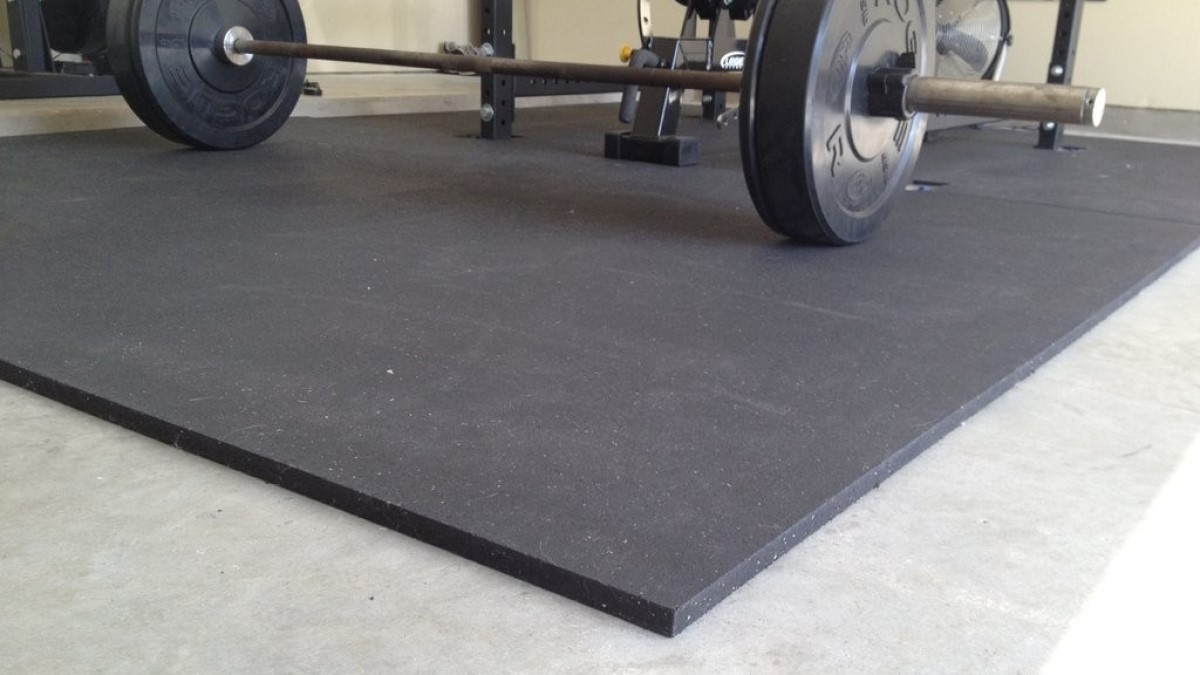
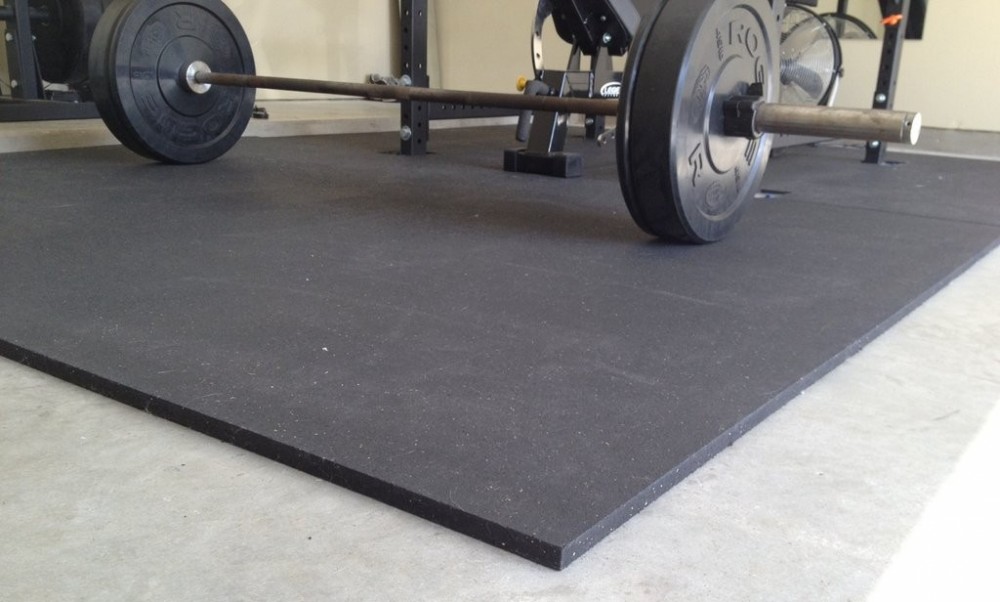
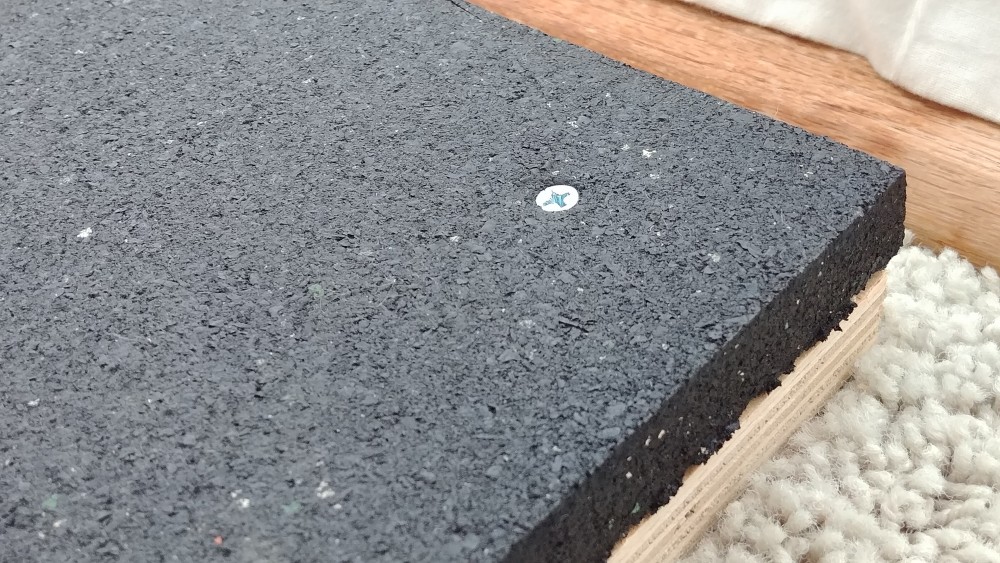
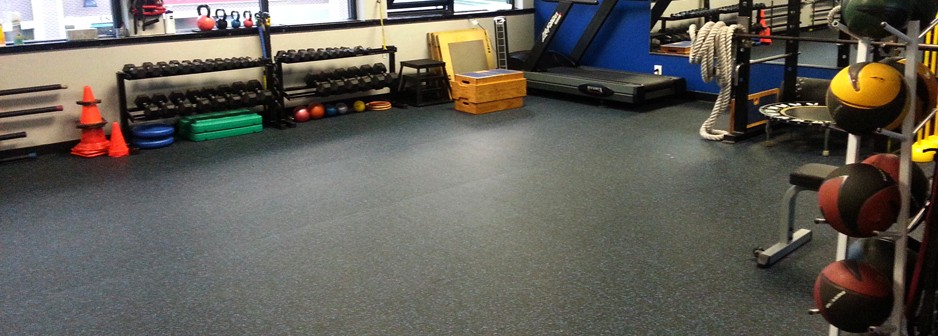
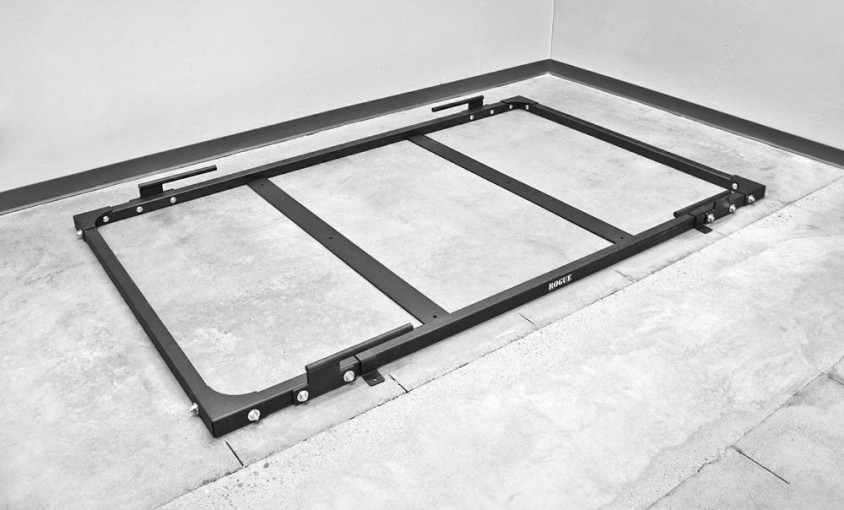
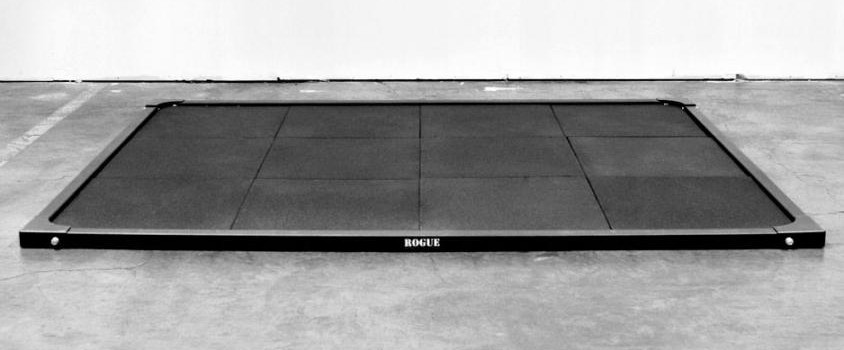
hi David,
I have mid/low (not sure) carpet level in my apartment bedroom which I will be converting to my personal home gym. I was wondering besides laying the 3/4 plywood down directly on the carpet itself as the base level, should I also use a canvas cloth to lay down underneath my plywood, and then 3/4 stall mat on top? My main concern is the mold or mildew problems by laying down the 2 layered platform directly onto the carpet. Thank you
PS. I know that ripping up the carpet is ideal, however, I don’t want to damage or change anything in my apartment flooring since they’ve just renovated the flooring on my unit.
There shouldn’t be any moisture going under the plywood even if you use a wet mop to clean it (but don’t splash it on), so I think that’s perfectly fine to lay it directly on without an extra layer.
Hi David, sorry to write so long after this was written… But I have a storage unit (concrete flooring) that I will be turning into a gym. I found some 3/8 flooring on craigslist from a renovated gym and I was curious if I needed to lay plywood on the floor? I will be deadlifting, hopefully atlas stone and log pressing (tires for log press drop). I’m green with working out so i plan on utilizing a 300lb weight set for quite some time lol, thank you!
That’s ok, I update this periodically and see the comments on all posts.
3/8 is fine for just generally gym flooring, but if you’re going to be dropping anything I would highly recommend using an additional layer of something. I know plywood is expensive right now. The concrete at a storage place might be better than average, or you can pretend it is and see what happens.
I ended up getting plywood from a friend, traded some MMA memorabilia for some plywood. Saved about $800 (kidding but did save like $150). Thank you for the help!
Hi David,
I am setting up a home gym on my first floor at home over a carpeted floor, I intend to lay down the interlocking rubber tiles 12mm – 16mm for flooring protection. Could you please advise if it would be necessary to still have an underlay fitted and what rubber tile thickness would you recommend?
Again, from my room measurements, I would require 39 mats, with each rubber tile weighing about 5kg, am I right to be concerned about the rubber tiles weight on my flooring? I intend to put up a free-standing home multi gym pullup bar station (includes foldable bench) and the Bowflex dumbbells 0 to 40kg selectable in the room. Room also has a 25kg foldable bed in it.
Thanks
Hi David,
Thank you for all your tips. I purchased a raised hex bar which I will be using for deadlifts. I wish I had read this article prior to purchasing items.
I have a ceramic tile basement floor. I added three 4 x 7 layers of the “dreaded” evo puzzle mats. Then I placed a half-inch piece of plywood on top of them and a half inch rubber mat on top of that. The area is surrounded on 2 perpendicular brick walls and a cabinet on the 3rd side. So it is pretty much trapped to prevent the mats from sliding much. I don’t bounce the weights and have bumper weights. I am hoping this will be sufficient.
I thought it would be more stable to have the rubber mat on top of the wood instead of the reverse. Do you think this will work? My best lifting weight is 205 pounds and I am 150 pounds. Thank you!
Lynn
The way you have it should work fine if it feels good. Attach the plywood pieces together. See attached image. I should add it to this article. Messy job, but I basically chopped away some layers with a hammer and chisel to create a recessed area and screwed mending plates in.
Hi, thank you for all this information. It is very helpful. I live in an apartment with hardwood floors and am building my home gym in a spare bedroom. I am worried about the noise and vibration levels for the person below me even though I will be using bumper plates for lifting, as well as jumping up and down during HITT workouts. I am planning on using the stall mats with 3/4 plywood, however instead of the cork base layer, I am wondering about your thoughts on this product to prevent noise/vibration or your thoughts on the best combination to use.
Rug Pad USA, 7/16″ Thick, Felt and Rubber, 5’x8′, Superior Lock- Premium Non Slip Rug Padding for Hardwood Floors https://www.amazon.com/dp/B01HN8M72A/ref=cm_sw_r_cp_api_glc_fabc_lZnaGbAQAV80B
That’s kind of like having carpet under. Any kind of plush material under there is not ideal for stability. It could allow the top layer to sink under load. With 3/4″ plywood and 3/4″ rubber all connected together really well so that it’s a good solid platform, it ought to work fine for you and be better than nothing to cut noise. Update me when you’ve got it going!
Hi, David. We made a long series of platforms from scratch at the beginning of this year, with plywood, stall mats, steel L beams for trimming painted black, 4 by 8 pieces of maple Hardwood, and stair grip tape from the front to the back of the wood. We used oil based polyurethane for the maple, applying a couple layers, detracting members from coming to the gym for a day but we made it through… Anywho, this project did not last the test of time, getting all scratched up and beat up over the course of this year, even observing large dents and chips. They could have been due to setting a 45 down temporarily while loading a bar, or setting down a deadlift Jack after lowering the bar, as I have observed live watching a black scratch resulting from such while I’m in there lifting. Our maintenance staff would sweep and mop the floor daily, and we did our best to wipe down chalk and take good care of it, but seeing that hard work come to waste, we’re trying to figure out the best way to move forward. We thought about going all rubber, but members and trainers like the look of the wood. We have brainstorm some ideas, including using two by two self-adhesive 3 mm laminate tiles from rubber flooring Inc that look like wood grain, or ordering the top wood surface from a dealer that sells professional lifting platforms like Legend, dynamic, or Hammer Strength in a quantity equal to the amount of platforms we have, as alternatives for the wood centerpiece. We would even out the rubber portions where the weights land with an under layment surface under the stall mats which is equal in thickness to whatever surface we chose, or cut 4 foot by 8 foot 3/4 inch mats into 2 X 8 portions in the case of using the top wood layer from a platform dealer. Is there another idea or suggestion you would have other than those two above that could be a long- term solution for maintaining good Aesthetics with the wood surface of lifting Platforms in a professional gym environment? Hopefully this comment could help us in addition to many others out there with the same issue. Thank you David
I would suggest using a sheet of good plywood for the center strip instead of expensive hardwood, don’t apply any finish, screw it down with no glue, and replace it yearly or as needed. I think it’s common for gyms to do that where the owner has figured out how much abuse it can take from so many people. Or maybe have some Dead Wedges (the cheaper knockoffs are fine too) and see how long before they disappear instead of having deadlift jacks that ding up the wood. https://amzn.to/39Ec5X5
Hi David,
What an awesome write up and hands down the best I’ve read on gym Flooring. I’m planning on laying down stall mats in my garage gym, which is concrete, should i glue these down or what do you think it’s the best way to do this?
The other question is that I will have stall mats 3/4 of an inch thick and planning on having the rogue platform with their 1.5 inch thick rubber tile on top of the stall mats and will use bumper plates, will this be fine to do heavy loads from overhead?
And one last thing, I will have the rogue Castro outdoor rig on a concrete slab outside, if I lay down the stall mats on top, will they get ruined in the outdoor?
Thank you so much for the information and your wealth of knowledge.
Yikes, don’t glue them down! Stick these mending plates on the underside of the mats to hold them all together to stop them from shifting. Alan Thrall discovered this. I’ll have to add his video to the article. Pick these up at a Lowes or Home Depot.
https://www.lowes.com/pd/Simpson-Strong-Tie-MP-2-in-x-4-in-20-Gauge-Galvanized-Mending-Plate/1002681518
A platform on top of the mats will protect your floor well.
Stall mats outside are fine. UV degrades rubber, but stall mats have a rough texture already and were made to be used outside.
Hi David, Thanks for great write-up. I am planning to put the gym in my basement, but I have porcelain tiles. Wondering how to protect the porcelain tiles. I am not a heavy lifter, but will be doing mostly squats and deadlifts. Would a plywood and top with rubber mats/tiles would be good option?
Yes, but I would add something soft under the plywood to protect the porcelain from abrasion, like a cork underlay or canvas cloths.
Thank you so much David!
I’m trying to figure out what to do over the vinyl planks in my basement. Vinyl is pretty tough so I figure the interlocking rubber tiles should work. Now I’m wondering if I should put drop cloth underneath. Not planning on doing any olympic lifts, and I figure I can buy separate pads for deadlifts or just be gentle putting the weight down.
That might work fine. Let me know how it goes!
Hi David,
I am on the second floor and have a hardwood floor and planning to put together a small gym in a spare bedroom. My equipment is going to be a squat rack for doing squats, bench press, and some light deadlifts. Not going to be doing any olympic lifts. To prevent damage to the hardwood I plan to put on top of it a layer of plywood and rubber tiles on top of the plywood. My second goal is to make the whole thing as quiet as possible so as to not disturb the neighbors below me. I was thinking to place a thin cork layer under the plywood instead of the drop cloth to help with the sound absorption. Do you think cork will work better than drop cloth for the sound? Will it make the whole thing too squishy? I don’t drop the weights as I lift but worried that if the barbells fall in an accident … will that damage the hardwood?
As an alternative to the rubber tiles I am also considering rubbertop tiles which consisting of a thin rubber layer on top of an EVA layer. I know you advise against EVA but there will still be a thin rubber layer on top of the EVA and plywood and cork underneath. Or do you advise against this option?
Thank you
Cork sounds like a good idea. From what I understand, cork is a great soundproofer and ought to be solid enough with plywood on top. I will be interested to hear how it works out, and the thickness you use.
I would avoid the rubber-EVA tiles. I think any EVA portion will make it too squishy.
Hey Dave, great write up… found this site doing a search for outdoor gyms. I’ve got this partially enclosed shed that I want to set up my gym in. Problem is the flooring is sort of rickety, basically sheets of plywood attached to 2×6 beams underneath which I believe are sitting directly on the ground (I didn’t build it, came with the house when purchased). Additionally, the plywood isn’t flat anymore, so…
I assume a lifting platform would be a must but given the un-eveness of the floor, guessing this might still not be good enough. Would you think that laying a sheet of stall mats between rickety plywood floor and lifting platform would be sufficient? Shed is ~8’x16′ so I could conceivably cover the entire shed floor with stall mats (or maybe a rubber roll)
I was hoping to put in a full rack and I’m considering this space so I could do kipping pull ups as well as overhead lifts (my garage ceiling is only 87″ high and the only room with sufficiently high ceilings is the living room which is not really an option)
I would try to even out the floor somehow first. Maybe another layer of plywood with overlapped seams, with underlayment between the old and new plywood sheets to help stop them from slapping together?
Hey David – thanks for writing this up.
I just got a T3 for the garage gym I’m building at my new place. I was going to build a lifting platform and bolt it to that. Can I get away with sitting the platform and rack directly on the concrete? I have about 8’x16’ to work with, so would be nice to save money on 8×8 of flooring.
Yeah, should be fine as long as the concrete is good.
Hi David,
I have a wooden floor and was wondering if you recommend any specific drop cloth. Also I found this on homedepot (https://www.homedepot.com/p/CoverGrip-3-5-ft-x-12-ft-Safety-Drop-Cloth-351208/206033436), would you recommend this?
Also really appreciate all the detailed writeup. Was really helpful now that I am setting up my home gym.
Thank you.
That should be fine. Anything like that. I should add that you might be able to feel the hem of the cloth even through 3/4″ rubber, so unless you’re layering plywood and rubber on top of it you might want to cut the hems off. I noticed this when I folded a drop cloth to put under some rubber for extra thickness because I got one plywood sheet that was 1/32″ thicker than the rest.
David, thanks for the writeup. Need some advice based on your experience please.
I have a home gym setup using large 1/4″ rubber mats over short carpet (not industrial short, but shorter than the traditional fluffy residential carpets).
I mostly do single arm weights, body-weight exercises, jump squats, etc. (no overhead olympic drops), but want a bit more stable surface. Would adding a 1/4 or 1/2″ plywood be sufficient for a sub-layer, since my rubber is only 1/4″ thick? I need it mostly for surface stability (less give than the carpet).
Yes, that will do the trick to make it feel solid. I’d do at least 1/2″ plywood. That way you can attach the plywood pieces all together with mending plates like this
Great idea about the mending plates! Thanks!!
Would you recommend gluing the rubber mats to the plywood? I just layed mine on top of a short (berber) carpet, but the interlocking mats (3/8″ thick) separate over time. Now I am thinking of putting plywood over the carpet, then putting the mats on top of the plywood. But, I am not sure of this would stop the mats from separating over time. That’s why I was wondering if glueing would keep them in place better.
Glue sounds messy and might not work. Attach your plywood sheets together with mending plates, then screw the outside edges of the rubber around the perimeter of the area to the plywood with the screws recessed into the rubber far enough. You can also use a different kind of mending plate for the rubber.
More here
https://www.tworepcave.com/10631/garage-gym-chatter-alans-trick-and-some-equipment-that-isnt-sold-out/
Ended up buying stall mats after your recommendation and laying them over concrete floor. Just curious if you have noticed any wear on your equipment (particularly the barbell) by dropping the weights from overhead?
No issues with most good barbells, assuming it’s with bumper plates. Or if you’re at least being reasonably controlled with iron plates it’s fine. Cheap barbells, usually the kind included in an iron weight set, or about $100, will bend easily, or the bolt on the end will loosen or bend.
I bought a stall mat at Tractor Supply. 4×6 for $40. I would argue it’s the same exact thing as these other guys sell for $94. The only drawback is it stinks like rubber hardcore. So much, my wife asked me to put it in the garage to air out. lol. It’s bad.
Somehow I missed your comment months ago, but thanks for sharing! Yes, those mats from Tractor Supply are a good deal for stall mats. I went to one and they had pallets of stall mats out front with two guys dedicated to loading mats into pickup trucks for customers buying them for their home gyms. I just updated the post to mention those.
I have a gym with rubber tiles that need to be replaced as they are all scuffed but still functional. I have ordered rubber mats. Should I install the rubber mats over the existing rubber tiles or remove them and start fresh?
Layering them is no problem. Assuming the existing mats are firm as well, an extra layer will just give you better protection and won’t feel squishy.
Thanks David for your reply, I’ll give that a go and happy new year! :-)
Hey Kirsty, if you’re reading this, how did it go with gluing the mats together? Just curious!
Hi David,
I have purchased 4x6ft 18mm or 0.7 inch thickness rubber horse mats:
https://www.farmandcountrydirect.co.uk/product/animat-rubber-stable-mats/
I plan on putting it in my garage over a cement floor. Would you recommend an underlay or will the cement be well enough protected? Also thinking about sound reduction as well and if you had any suggestions for underlay for that?
I would be cleaning and dropping the weights 2-3 times a week.
Thank you very much,
Jack
Hi Jack,
Those are definitely the right mats!
If you use Hi Temp bumper plates your concrete will be good. They bounce high instead of transferring so much energy into the floor.
With other bumpers, concrete damage sometimes does happen over time. Some concrete floors are weaker than others. The safest thing to do is double up those mats.
Hi David,
Thank you for your quick reply!
These were the ones I was thinking of I think they are the similar (I am based in the UK):
https://wolverson-fitness.co.uk/collections/plates/products/bison-high-impact-bumper-plates
I may well have off cuts as the mats do not fit exactly into the space and use them as extra support when lifting heavier!
Thank you very much for your help!
Jack
Those should work good! They look virtually the same as the Vulcan Alpha bumpers, a softer rubber but with low bounce unlike Hi Temps.
Hi David,
I have something similar to the EVA mats that I purchased here (New Zealand) over the concrete floor in my garage/home gym. These work reasonably well for my plyometric training/circuit training however after 4 years of use, this flooring is starting to lose its cushioning.
I would like to put a second layer of these mats on top but need to somehow affix them together so that when I’m doing burpees, box jumps etc they are not going to slide.
Because I need to also park my car in the garage in between workouts, I am wanting to affix the rubber mat layers together, not fix the mat to the floor as I lean the mats against the garage walls when not in use.
Can you recommend an adhesive or glue that would be strong enough?
Thanks so much!
Kirsty
Kirsty,
I’m not sure about the adhesive, but I would probably get a tube of adhesive that looks like this, either something all purpose or made for foam surfaces if that exists:
http://amzn.to/2DwqVeZ
If you try to glue only certain spots minimally and not the entire surface, you might run into the surfaces slapping each other.
Ok, thanks! I have tile floor above concrete subfloor, my plan is to build a standard 8×8 lifting platform out plywood and horse stall mats. Since firmer is better, would laying down four 4×6 horse stall mats and building the platform ensure better protection tile floor? A few of the tiles are uneven. Could the mats themselves damage the tiles in some way, or lead to water pooling underneath them? Perhaps I should lay the canvas drop cloth beneath the horse stall mats as the first layer? No dropped weights, just deadlifts (~300-400lb at the moment) lowered quickly to the platform.
Right, I’d put something like the drop cloth as the first layer to protect the tile even from just rubber. Rubber will probably leave marks on it. Moisture shouldn’t be an issue as long as you only do light mopping.
I would want the plywood as well to distribute the impact and protect the tile, but the platform will do it. I’ll be interested to hear how it goes, but sounds fine. As a reference point, concrete gets pulverized from enough drops (cleans/snatches) when only protected by a layer of rubber mats, but with only deadlifts and a platform I can’t imagine you would do damage. The uneven tiles might be troublesome, maybe requiring another layer of canvas or something on the other tiles to even things out.
What type of thin foam underlay would you recommend to put between tile floor and plywood? How thick should it be?
Good question! A canvas drop cloth under the plywood would prevent the possibility of the plywood scuffing the tile. Here’s a 12×15 one: http://amzn.to/2wiWp5Z
3/4″ plywood and 1/2″-3/4″ rubber on top of that should do the trick to absorb impact, as long as you aren’t doing anything extreme like dropping weights from shoulder height.
I’d steer away from foam underlayment, because it’s designed to add a tiny amount of cushion, and that’s a bad thing for this application. The firmer the better.
I’ll have to add a note about it to this article.